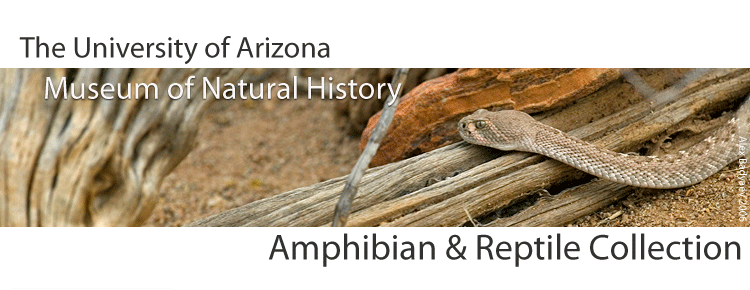Data
Requests
Specific information associated with specimens in the UAZ Collection
of Amphibians and Reptiles can be made available on request. Data
requests should be made via email or letter, and follow the format
for specimen loan requests. Generally, legitimate and well thought
out data requests are replied to as promptly as possible with all
requested information available, however, specific information,
or on occasion, the entire request may be withheld if sensitive
populations or species are deemed at risk. When making a data request,
be sure to let us know the types of information needed. Typically,
a data request is processed and answered utilizing a spreadsheet
attachment via e-mail. Hardcopy replies can be provided for requests
generating limited data.
Specimen
Acquisitions and Donations
The
University of Arizona Herpetology Collection grows and becomes a
more useful research resource with the acquisition of specimens.
These specimens are typically acquired through collecting efforts
of the collection staff or students and researchers associated with
the collection. Specimens are also gained through exchanges from
other institutions, as well as gifts and donations. New acquisitions
are welcome, given that they are legally possessed, and have complete
and reliable collection information. Complete collection information
includes at a minimum:
1)
Collector(s) name (the collectors catalog number should be included
if available)
2) Date of collection (should be written out as 12 May 2002 or May
12, 2002 if possible).
3) Collection locality which should include Country (if outside
of the United States), State and County (if applicable), as well
as a specific locality. This more precise locality may include mileages
from landmarks, and / or geographic coordinates such as Range and
Township, Latitude and Longitude, or Universal Transverse Mercator
(UTM). The recent accessibility of relatively inexpensive Geographic
Positioning System (GPS) receivers, has made acquiring these precise
localities much quicker, easier, and with increased accuracy. Whenever
possible, the elevation should be included with the locality.
Other
useful, but non obligatory, information often included with specimens
are time of collection, weather conditions, description of vegetation,
description of physical area, major drainage, mountain range, valley
name, collected live or dead, live on road (LOR), dead on road (DOR),
and date of preservation. Field notes and collecting permits (originals
or copies), associated with the donated specimens are also appreciated.

